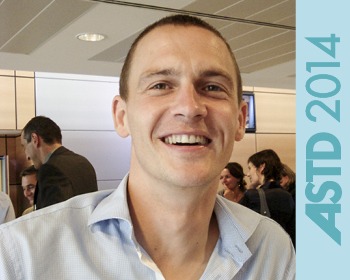Session SU101 is proof that you really DO need to get there on time. I sneaked in around the back to secure one of the final seats in what is clearly a popular session: Josh Davis on the “NeuroScience of Learning”, which promises to supply general design principles for how to create behavior change in leaders…
Davis is interested in why many one-shot training sessions don’t stick and don’t make the change they were designed to achieve. Asking the audience, we can see that almost everyone finds that people learn at their training events, but then never use what they learn and end up forgetting it. Why is this? The NeuroLeadership Institute has been trying to find out why.
At the root of the problem is the hippocampus, which deals with attention, generating links, emotions and spacing. Due to its central position is the brain, the hippocampus is responsible for coordinating the neural connections required to create memory and habit. To create a rich web of connections in the brain, you need to engage the hippocampus.
1. Davis starts by telling us about attention. Attention is not designed to last. It is designed to keep looking around and being aware of what’s going on. If you don’t, you die. Simple.
Attention can last about 20 minutes. And of course, in the training game, we tend to work a lot more than that! But in today’s learning environment, we must be aware that we are fighting more-and-more for attention from participants. According to one study, today’s multi-tasking high-media users have significantly diminished capacity for attention. Even when asked to remember something for just 1 minute, they do a lot worse than their non-connected single-focused colleagues. But it’s worse than that: Their multi-tasking tweeting, iPhoning activities is making it harder for the others to pay attention.
What’s the point? Single focus of attention is required to tell the hippocampus that what we are looking at is something to recall. Divided attention doesn’t do that.
2. Once you have attention, the ability to generate links to what you already have in your brain becomes important…
Don’t forget, the hippocampus is trying to make links in the brain. It tells puts together everything that is going on about feelings, visual stimuli, thoughts, previous knowledge and memories etc.. As learning professionals, we need to help it.
If you want to help the hippocampus to do this, there are a few things to do:
- Metacognition (or thinking about thinking) is a great approach. Self-reflection on the learning process generates more connections, which will make the content more easy to recall. For example if we were trying to remember a specific word, we could think about how it looks on the paper, or how it sounds in our ears when we speak it out loud. We try to get the brain more aware of what is going on while it processes the information.
- Retrieval strategies are all about practising recall of what is being processed. If you don’t test retrieval, your chances are significantly lower of remembering than if you practised remembering several times.
- Insight activities or moments help to promote memory of content. If you can create real “ah-ha” moments, where people finally “get-it” your participants will be more likely to remember. Davis says that this is because the “ah-ha” insight moment adds a level of emotion to the experience.
Davis offers some simple strategies you can use in training: Polling, guided reflection on personal experiences, note-making, explaining ideas to others (and creating tweetable messages or mini-presentations) and hearing ideas from others.
3. Third tip: Scare people!
…OK, not really. But kind of! Davis explains that because of the proximity of the amygdala to the hippocampus, if we can create emotion in learning, there is more chance to build attention and lasting memory.
As we are more emotionally aroused, the amount of catecholamines released into the brain by the amygdala changes. Davis says that we need to find the sweet spot of optimal-arousal that improves attention, but not so much that things get scary.
Tactics for trainers to influence emotion in the room include those covered by NeuroLeadership Institute CEO David Rock in this paper on SCARF. During the session, Davis asked us to look for other ways. He gave us 90-seconds and told us to write hem down. Afterwards, he added that he did this to create a little pressure. That little bit of negative-emotion can improve attention. So can sweets, humour, music…
4. Finally: Spacing in the learning process
It’s not enough to just throw something into the memory and hope it stays there. We have to grow the memories. By building in moments of rest and reactivation, people are more likely to remember things. Three strategies:
- If you come back to them later (repetition) with questions and reinforcement of content, they are more likely to remember.
- If you can change the context of what is being learnt (or even where it is being learnt), this is also more likely to make sticky learning.
- Sleep! Yes, really!
I had contacted Josh Davis prior to the session to ask him if the session was going to be very “deep” and heavy on facts, figures, statistics and studies (all of which I am allergic to in conferences). He told me that the session was scoped for starters, people with not much knowledge about NeuroScience. I am pleased to report that that was the case and as a very positive outcome, I have learnt something: If you want to make learning stick, you need 4 strategies to engage the hippocampus.






